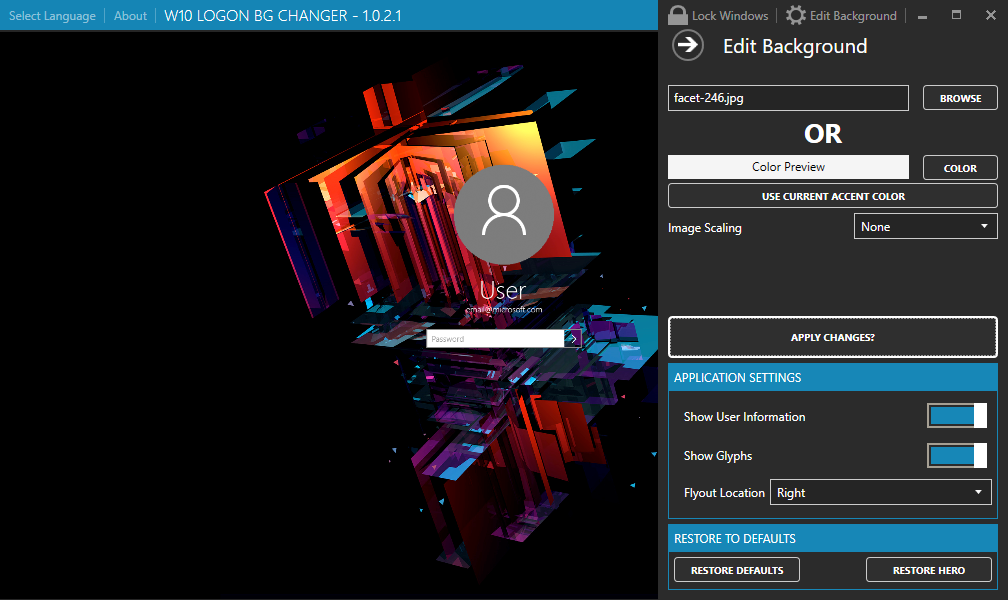
See the `` Using XDM(1)'' section, below. ( Note: this doesn't work if thescreensaver is launched by xdm(1)because it can't know the user-id of the logged-in user.

#CUSTOMIZE XSCREENSAVER LOCK SCREEN PASSWORD#
lock (class Boolean) Enable locking: before the screensaver will turn off, it will require you to type the password of the logged-in user (really, the person who ranxscreensaver), or the root password. If this is 0, then the graphics hack will never be changed:only one demo will run until the screensaver is deactivated by user activity.Default 10 minutes. cycle (class Time) After the screensaver has been running for this many minutes, the currentlyrunning graphics-hack sub-process will be killed (with SIGTERM), and anew one started. Timeout (class Time) The screensaver will activate (blank the screen) after the keyboard andmouse have been idle for this many minutes.

Xdefaults file and the app-defaults file will never bewritten by xscreensaver itself.) When settings are changed in the Preferences dialog box (see above)the current settings will be written to the. The app-defaults file willusually be named /usr/lib/X11/app-defaults/XScreenSaver, but differentsystems might keep it in a different place (for example,/usr/openwin/lib/app-defaults/XScreenSaver on Solaris.) If you want to set the system-wide defaults, then make your edits tothe xscreensaver app-defaults file, which should have been installedwhen xscreensaver itself was installed. Xdefaults file, you might also need to run xrdb(1): If you change a setting in your X resource database, or if you wantxscreensaver to notice your changes immediately instead of the next timeit wakes up, then you will need to tell the running xscreensaver processto re-initialize itself, like so: (The file willbe reloaded the next time the screen saver needs to take some action, such asblanking or unblanking the screen, or picking a new graphics mode.) xscreensaver file while xscreensaveris already running, it will notice this, and reload the file. xscreensaver file, you would write the following: Xdefaults file for example, to set the timeout paramterin the. xscreensaver file is similar to that ofthe. xscreensaver file exists, it overrides any settingsin the resource database. xscreensaver file in your home directory or in the X resourcedatabase. Options to xscreensaver are stored in one of two places: in a. The rest of thismanual page describes lower level ways of changing settings.


CONFIGURATIONThe easiest way to configure xscreensaver is to simply run the xscreensaver-demo(1)program, and change the settings through the GUI. Note:unlike xlock(1),xscreensaver has a client-server model: the xscreensaver program is adaemon that runs in the background it is controlled by the foreground xscreensaver-demo(1)and xscreensaver-command(1)programs. The xscreensaver-demo(1)program pops up a dialog box that lets you configure the screen saver,and experiment with the various display modes. GETTING STARTEDFor the impatient, try this: It also provides configuration and control of your monitor's power-savingfeatures. This program can lock your terminal in order to prevent others from using it,though its default mode of operation is merely to display pretty pictures onyour screen when it is not in use. It turns off as soon as there is any mouse or keyboard activity.
#CUSTOMIZE XSCREENSAVER LOCK SCREEN PLUS#
Index NAMExscreensaver - extensible screen saver framework, plus locking SYNOPSIS xscreensaver DESCRIPTIONThe xscreensaver program waits until the keyboard and mouse have been idle for a period, and then runs a graphics demo chosen at random.


 0 kommentar(er)
0 kommentar(er)
